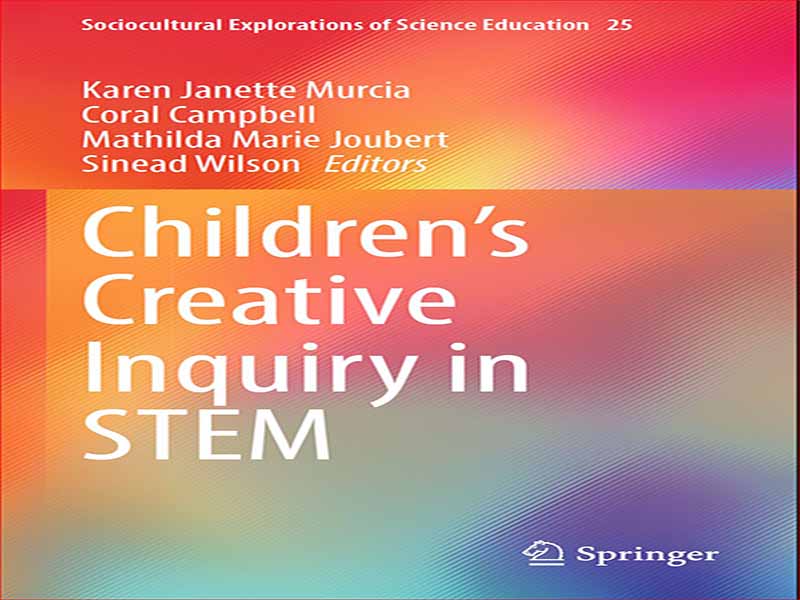- عنوان کتاب: Children’s Creative Inquiry in STEM
- نویسنده: Karen Janette Murcia
- حوزه: خلاقیت کودکان
- سال انتشار: 2022
- تعداد صفحه: 370
- زبان اصلی: انگلیسی
- نوع فایل: pdf
- حجم فایل: 11.0 مگابایت
این کتاب بر اساس چند واقعیت اساسی است. 1 بیشتر کودکان با استعداد و با استعداد در مدرسه ابتدایی محلی خود آموزش می بینند. 2 به عنوان یک معلم ابتدایی، در کلاس خود فرزندانی خواهید داشت که قادر به رفتارهای با استعداد و/یا با استعداد هستند. 3 یکی از سخت ترین جنبه های معلم ابتدایی بودن، فراهم کردن مناسب طیف روزافزون توانایی ها در کلاس است. با نگاهی دقیق به چگونگی ایجاد چالشهای مناسب برای دانشآموزان با استعداد و با استعداد، میتوانیم چیزهای زیادی در مورد چگونگی طراحی فعالیتهای بهتر برای همه کودکان بیاموزیم. توانایی های خود را نشان داده و توسعه دهند. بسیاری از نویسندگان و محققان پیشنهاد کردهاند که آنچه معلمان و دانشآموزان درباره استعدادها و استعدادها باور دارند، در هر چیزی که در کلاس اتفاق میافتد نفوذ کرده و تأثیر میگذارد. این باورها بر روحیه ای که معلمان ایجاد می کنند، انواع فعالیت هایی که طراحی و ارائه می کنند، و نوع بازخوردی که به دانش آموزان درباره کار و رفتارشان می دهند، تأثیر می گذارد. در نتیجه، فصل 1 کاملاً به این ایده از باورها و تأثیر آنها بر روابط معلم و شاگرد و عملکرد دانشآموز نگاه میکند. برای مدت طولانی در آموزش و پرورش ما تمایل داشتیم که بر تفاوت های بین دانش آموزان تمرکز کنیم. این تفاوت ها با این ایده که درمان های متفاوتی مورد نیاز است، تشخیص داده شده و مستند شده است. این باعث شده است که برخی از کودکان از جریان اصلی جدا شوند و برخی از معلمان بر این باورند که برای آموزش این «انواع» کودکان به تخصص خاصی نیاز است. در حالی که تشخیص این تفاوت و تنوع مهم است، نباید این واقعیت را فراموش کنیم که زبان آموزان نیز اشتراکات بسیار زیادی دارند. در مدارس ابتدایی، زمانی که احتمالاً کلاسهای توانایی مختلط را آموزش میدهیم، استفاده از این «اشتراعات» برای کمک به طراحی فعالیتهایی که شامل همه فراگیران کلاس میشود، مفید است. فصل 2 به طور خاص به وجوه مشترک یادگیرندگان می پردازد. پس از نگاهی به باورها و اشتراکات، بقیه کتاب را به بررسی راههای سازماندهی و ساختاردهی فعالیتها در کلاس ابتدایی خواهیم پرداخت. به طور خاص روی اطمینان از اینکه سطوح بالایی از چالش برای آن دسته از کودکانی که آماده آن هستند، تمرکز کنید.
This book is based on a few basic realities. 1 Most gifted and talented children are educated in their local primary school. 2 As a primary teacher you will have children in your class capable of gifted and/or talented behaviours. 3 One of the most difficult aspects of being a primary teacher is providing appropriately for an ever-increasing range of abilities in the class. By looking closely at how to provide appropriate challenges for gifted and talented pupils we can learn a lot about how to design better activities for all children.This book is about designing activities that encourage all children, and most especially the gifted and talented, to both demonstrate and develop their abilities. Many writers and researchersi have suggested that what teachers and pupils believe about gifts and talents permeate and influence everything that happens in the classroom. These beliefs impact on the ethos that teachers create, the types of activities that they design and offer, and the type of feedback that they give to pupils about their work and about their behaviour. As a result Chapter 1 will look quite closely at this idea of beliefs and their influence on teacher–pupil relationships and pupil performance. For a long time in education we have tended to concentrate on the differences between pupilsii. These differences have been diagnosed and documented with the idea that different treatments are required. This has led to some children being separated off from the mainstream and some teachers believing that special expertise is required in order to teach these different ‘types’ of children. While recognising that difference and diversity is important we mustn’t lose sight of the fact that learners also have an awful lot in common. In primary schools, when we are likely to be teaching mixed ability classes, it is useful to use these ‘commonalities’ to help us to design activities that include all learners in the class. Chapter 2 will look specifically at what learners have in common. Following the look at beliefs and commonalities we will spend the rest of the book looking at ways of organising and structuring activities in the primary classroom that provide a sense of community and coherence to what might appear to be a very disparate group of learners.We will concentrate specifically on making sure that high levels of challenge are provided for those children who are ready for it.
این کتاب را بصورت رایگان از لینک زیر دانلود نمایید.
Download: Children’s Creative Inquiry in STEM




































نظرات کاربران